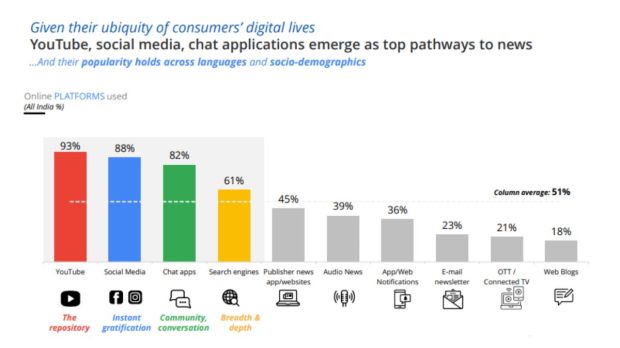Publishers websites and mobile apps are important pathways to news as per the report ‘India Languages: Understanding India’s Digital News Consumer’ by Google in collaboration with Kantar. Users also go to multiple sources to know the truth. The data says, an Indian language consumer uses as many as 5.05 platforms on an average to access news online with 93% using YouTube, 88% social media and 82% people consuming news from Chat apps while only 45% online news users discover news via either publisher’s website or apps.
Entertainment, crime and headlines pique users’ interest the most in the core news segment, cites the report. However, health, tech and fashion categories capture the most attention in the non-core news segment. The report further mentions low quality copy editing, bombarding users with excessive ads and poor UX designs emerge as the top three pain areas for online news experience on Indian language websites and apps.

Trust, simple language articulation and credible news sources are the top three levers driving online news consumption in Indian languages. 7 out of 10 news online news users claim to be consuming locality, neighborhood news, predominantly in Hindi and Gujrati. Thus, Indian language publishers can focus on hyperlocal news.
According to the report, 89% believe that a credible source of news is one of the top drivers for users while 84% users are keen on news that is research backed. 73% users want supportive visuals with concise and easy language to understand.
Speaking on the different kinds of news users in the country, Sanjay Gupta, country head and vice president, Google, said, “Users in India are not different on the back of language but on the beliefs and their socio-economic backgrounds.”

The report further highlights that 15% of news users are ready to pay for online news and the readiness is 1.5 times higher among publisher website/app users, that is, 22% among publishers website/app users. The profile is skewed to highly educated, English knowing, affluent millennials. Citing top motivations for the desire to pay for news online, the report stated that conciseness, quality, fact checking, and exclusive information underpin the desire to pay.
One in five users face misinformation challenge. Approximately 80% encounter misinformation as it has been rampant in Bengali and Marathi news. Users have strayed from news largely due to unedited news, ads and UX issues, as per the reports.
The report stated that two in three consumers receive news from aggregators as well as publisher’s app. Bengali and Marathi users has the lowest overlap amongst the other 6 languages at 33% and 53% respectively. Moreover, the top motivations for paying for news online are conciseness, quality, fact-checking and exclusive information. There is approximately 73% user base with an interest in hyperlocal news.
Additionally, monthly fixed payment and quarterly fixed payment collectively is able to capture 3 in 5 consumers, according to the report. The hunger for snackable content is evident across both video and text formats. The report states that 70% of news users are interested in reading news summaries while only 48% users are interested in long form content. Similarly, 25% users watch clips under 60 seconds while only 19% users watch in-depth clips while 70% users read summaries and 67% users read top story headlines.
The report further stated video ads were the most popular format standing at 57% followed by interactive and static format at a joint 45%.
Furthermore, shedding light on the proliferation of fake news, the report states that 80% news users come across suspicious or fake information with Bengali and Marathi speakers occupying a greater share in the pie. Also, 43% fake news spread via Whatsapp in the country.


